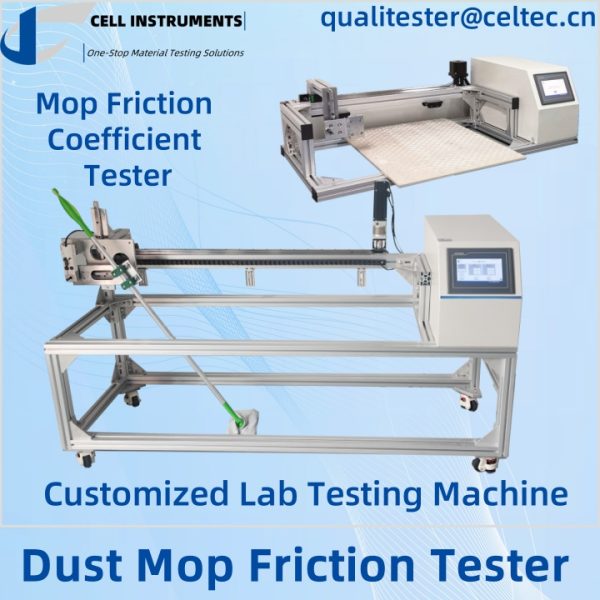How to Conduct a Dust Mop Friction Test: Ensuring Quality and Efficiency
For cleaning materials, ensuring that products meet high-quality standards is crucial. One of the most effective ways to evaluate these materials is through a dust mop friction test. This process measures the resistance of a mop’s surface as it interacts with various floor types, giving manufacturers insight into how well the mop performs under real-world conditions.
The Importance of Dust Mop Friction Testing
Evaluating the friction of mops and other cleaning materials provides essential data on their cleaning efficacy. By using a dust mop friction test, manufacturers can determine how much force is required to move the mop across a surface, which directly relates to how efficiently it can clean. This test is particularly vital for both home and industrial cleaning materials, where performance must be reliable and consistent.
Using Mop Friction Coefficient Testers for Accurate Results
To perform a dust mop friction test, it is critical to have a reliable testing machine like the mop friction coefficient tester. This instrument, available from Cell Instruments, offers precise, real-time measurements of the friction force between the mop and the testing surface. Equipped with a high-speed linear guide and a sensitive load cell, the tester ensures that manufacturers receive accurate, repeatable results every time.
How the Dust Mop Friction Test Works
Performing a dust mop friction test involves several key steps that simulate real-world conditions. Here’s a typical step-by-step process:
Securing the Sample: The cleaning material, often a mop head, is attached to the machine’s test surface. Ensuring a secure fit is crucial for obtaining consistent results.
Setting the Test Parameters: Adjust the pressure, speed, and movement settings to mimic different cleaning scenarios. For instance, a higher pressure may be used to simulate scrubbing actions on rough floors, while lower pressure tests may replicate a light dusting action on smoother surfaces.
Conducting the Test: The machine moves the mop head across the surface, recording the friction force data in real-time. The results show how easily the mop moves over different surfaces and how effective it will be at picking up dirt.
Analyzing the Data: The final step is to evaluate the collected data, focusing on key factors such as friction resistance, cleaning performance, and wear on the mop material.
Applications of Dust Mop Friction Testing
Mop friction testing has broad applications in various industries, including:
- Home Cleaning Products: Testing the friction efficiency of mops used in domestic cleaning.
- Industrial Cleaning: Evaluating the effectiveness of mops used in large-scale operations such as hospitals or factories.
- Medical and Pharmaceutical Industries: Ensuring that cleaning materials meet stringent hygiene and sterility requirements.
- Textiles and Packaging: Assessing the durability and efficiency of mop fabrics used in cleaning delicate surfaces.
Customization Options for Mop Friction Testers
At Cell Instruments, we understand that different industries have unique testing needs. Our mop friction coefficient tester can be customized to meet specific testing protocols, whether for varying surfaces or pressure requirements. Customizable features include:
- Software Customization: Adjusting test parameters for specific industry needs.
- Fixture Customization: Modifying the device to test different mop designs or cleaning materials.
The Role of Dust Mop Friction Tests in Product Development
Dust mop friction tests provide manufacturers with invaluable data, allowing them to improve their products continually. By identifying potential issues such as material wear or insufficient cleaning force early in the development process, manufacturers can optimize mop design and performance. This leads to better products, higher customer satisfaction, and increased market competitiveness.
Benefits of Using Cell Instruments’ Mop Friction Tester
Using our mop friction coefficient tester offers several advantages:
- Enhanced Quality Control: Test results ensure mops meet strict performance standards.
- Improved Efficiency: Automation reduces testing time and labor costs.
- Innovative Product Development: Accurate data drives continuous improvement in cleaning material design.
For companies that prioritize quality and customer satisfaction, investing in a reliable mop friction tester is essential.
FAQ
Why is dust mop friction testing important?
Dust mop friction testing measures the cleaning efficiency of mops by evaluating how much friction is generated when the mop moves across a surface. This helps manufacturers ensure their products meet high-performance standards.What industries benefit from dust mop friction testing?
Industries such as home cleaning, industrial maintenance, medical facilities, and packaging all benefit from mop friction testing, as it ensures their cleaning materials are both effective and durable.How does the mop friction coefficient tester work?
The tester applies controlled pressure and movement to a mop sample, measuring the friction force in real-time. This data helps manufacturers evaluate the mop’s cleaning efficiency and durability.Can the mop friction tester be customized?
Yes, Cell Instruments offers customization options, including software and fixture adjustments, to meet specific testing requirements for different industries.What is the significance of friction resistance in mop testing?
Friction resistance is a key indicator of how well a mop will clean various surfaces. High friction resistance often means the mop can remove dirt effectively, while lower resistance could indicate reduced cleaning efficacy.

